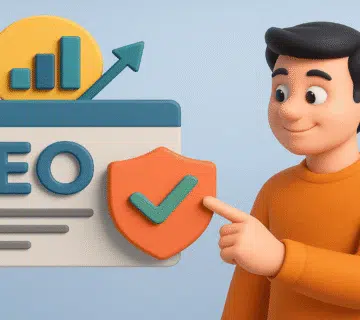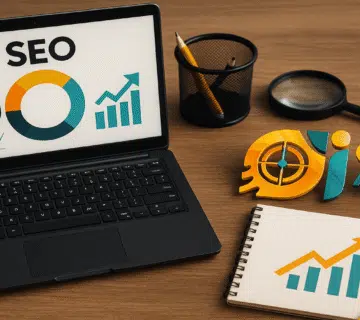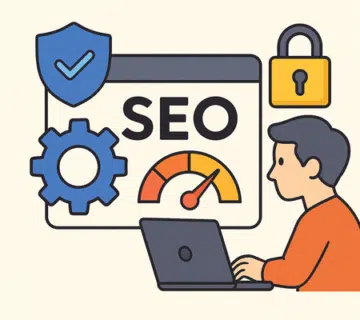Improving Your Google Visibility
What is Search Engine Optimization (SEO)?
Search Engine Optimization (SEO) is a set of strategies and techniques designed to increase the visibility of websites in search engine results, especially Google. SEO is considered one of the core components of digital marketing.
Its goal is to improve the user experience and increase website traffic by using relevant keywords, enhancing site structure, and improving overall quality.
When a user searches for specific information, Google analyzes many factors to determine the most relevant pages to display in the results.
Some of these factors include content quality, page loading speed, and backlinks. Backlinks are links from other websites that point to your site, acting as important indicators of credibility for search engines.
There are two main types of SEO: On-page SEO and Off-page SEO. On-page SEO refers to all activities carried out within the website to increase its visibility in search engine results. These activities include content optimization, content structuring, and ensuring the site is mobile-friendly.
In contrast, Off-page SEO is related to external factors that influence a site’s ranking, such as links from other websites and social media platforms. Combining on-page and off-page SEO strategies is critical to achieving positive and sustainable results in enhancing a website’s visibility on Google.

The Importance of Keywords in SEO
Keywords are one of the essential elements of Search Engine Optimization (SEO), playing a vital role in determining how your content reaches your target audience.
It’s not just about selecting the right keywords, but also about understanding how to use them effectively to attract visitors and improve rankings in search engine results. Keyword research can be conducted using tools like Google Keyword Planner, SEMrush, and Ahrefs, which help identify the most popular and frequently searched terms.
Once the keywords are identified, it’s important to integrate them naturally into the text, headings, and page descriptions. These keywords should be relevant to the page content to provide valuable information for both readers and search engines aiming to assess content quality.
Using keywords in headings captures the reader’s attention early on, while also enhancing content discoverability by search engines.
Moreover, long-tail keywords are particularly important when targeting specific audiences. These keywords reflect more precise queries and can offer a better opportunity to compete in search results. For example, instead of targeting a broad term like “clothing,”
you could target a more specific phrase like “summer sportswear for women.” This optimization helps attract users looking for something specific, increasing the likelihood of converting them into potential customers.
Therefore, keyword strategy should be a central part of any SEO plan to make your content more visible and effective.
Performance Analysis and Strategy Adjustment
Performance analysis is a vital tool in enhancing website visibility on search engines, as it determines the effectiveness of the SEO strategies in place. One of the primary tools for this task is Google Analytics, which provides detailed insights into user behavior on your website. Using Google Analytics,
you can track the number of visits, bounce rates, traffic sources, and even the most visited pages. This data allows you to understand trends and how users interact with your content, making it easier to make informed decisions for strategy adjustments.
On the other hand, Google Search Console is another essential tool for understanding how search engines view your site. It offers reports on entry pages, technical errors, and the search queries that lead to your site appearing in results.
This information highlights opportunities to improve SEO, such as refining titles, meta descriptions, and loading speed. By analyzing performance with these tools, you can develop data-driven strategies.
Once you gather data from analytics tools, the next step is adjusting your strategies based on the findings. If certain keywords are performing better than others, you should redirect efforts toward enhancing related content.
The data may also reveal high bounce rates on specific pages, requiring improvements in content or user experience. Through continuous performance reviews and strategy adjustments, you can improve your site’s ranking in search engines and achieve better results over time.

Best Practices for On-Page SEO
On-page SEO is a crucial element in attracting visitors and increasing a website’s visibility in search engine results. One fundamental factor is the effective use of headings. Headings should include the target keywords,
helping search engines understand the content of the page. It’s also important that headings are clear and appealing to users.
Meta descriptions are another key factor in SEO improvement, as they should offer an engaging summary of the content. A compelling description can significantly influence click-through rates, so it must be attractive and motivating. It should include the target keyword without excessive stuffing to maintain clarity and smooth reading.
Internal linking is another essential on-page SEO technique. Linking related content within your website helps guide visitors to other pages, increasing the time they spend on the site.
This also enhances the chances of improving page rankings in search results. The links must be contextually relevant, making it easier for users to navigate and understand your site as a whole.
Image optimization also contributes to SEO. You should use alt text and file names that reflect the image’s content. This not only helps improve page relevance for search engines,
but also enhances the user experience. Structured data, used to better define content, also plays a role in improving rankings.
Ultimately, user experience should not be overlooked as a critical SEO factor. The site should be user-friendly, fast-loading, and responsive across all devices. Improving these aspects increases visitor retention time, which helps boost your site’s ranking in search results.







No comment